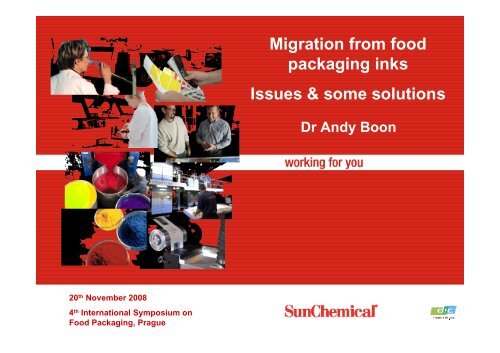Migration from food packaging inks Issues & some solutions
Migration from food packaging inks Issues & some solutions
Migration from food packaging inks Issues & some solutions
Create successful ePaper yourself
Turn your PDF publications into a flip-book with our unique Google optimized e-Paper software.
Legislation – Plastics• Plastics Directive 2002/72/EC• only applies to materials made exclusively ofplastics• lists do not include substances only used in themanufacture of <strong>packaging</strong> <strong>inks</strong>• Regenerated Cellulose Film Directive 2007/42/EC• Printed surfaces must not contact the <strong>food</strong>stuffs• No specific legislation for <strong>packaging</strong> <strong>inks</strong>4
Legislation – What about GMP ?• 2023/2006/EC elaborates GMP requirements for1935/2004 (Food Contact Materials)• Responsibility to observe GMP in the supply chain• Separate Annex mentions printing <strong>inks</strong>:•“Processes involving the application of printing <strong>inks</strong>to the non-<strong>food</strong> contact side of a material or article”• Legal opinion – concerns the applicationprocesses, i.e. formulated (= press side mixing/adhesive interactions), applied (= printing), handledand stored to avoid set-off and through migration• Not a specific obligation on ink manufacturers5
Legislation – Relevance of 1935/2004/EC ?• “On materials and articles intended to comeinto contact with <strong>food</strong>”• No mention of <strong>inks</strong> in 89/109/EEC• Printing <strong>inks</strong> first mentioned in 1935/2004/ECin Annex I• Legal opinion considers this refers only tothose <strong>inks</strong> intended for <strong>food</strong> contact‣ i.e. for printing on the <strong>food</strong> contact surface• Does not apply to <strong>packaging</strong> <strong>inks</strong> per se but doesapply to the ‘finished’ <strong>packaging</strong> once printed6
Terminology• Printing <strong>inks</strong> are supplied in a wet state• Inks have to be printed onto a substrate• Inks have to be dried• Easily transferred‣ Touch it and you get covered in ink• Not accurate to talk about migration <strong>from</strong> ink• Should strictly refer to migration <strong>from</strong> print orbetter still - printed articles7
Process - 1InkSubstrateFountPrinting pressDryingPrinted substrateCleanersStorage8
Process - 2Printed substratePackaging manufactureFoodPackaged <strong>food</strong>Further processingCooking in <strong>packaging</strong>StorageConsumption9
Variables influencing migration <strong>from</strong> printThe ink manufacturer cannot ensure complianceof the <strong>packaging</strong>• Too many variables outside our control:• substrate selection• barrier properties• surface treatment• print design• ink coverage• film weight• press type & speed• drying conditions• ambient temperature• <strong>packaging</strong> design• lamination adhesiveand conditions• effects of other layers• nature of packaged<strong>food</strong>stuff• storage conditions(time, temperature)• humidity etc, etc11
Substrate effects on migration <strong>from</strong> printPE PET PE OPP PE PE OPP OPP PET PET Al foilOPPDEHADBPDCHPDPOPNETSA12
Variables – Unexpected contaminationPotential sources of contamination• Press washes and cleaning agents• Fountain solution• Substrate - especially if recycled content• Leaching <strong>from</strong> press rollers & ink train• Storage pallets• Adjacent storage• Vehicle and Fork Lift Truck emissions• Atmospheric contaminants13
Ink manufacturers response• General duty of care and product stewardship• Responsibility in the Supply Chain <strong>from</strong> GMP• Withdrawal of supply for certain applications• Active R&D programmes ongoing many years• Availability of next generation Low <strong>Migration</strong>products (e.g. Irocart LMQ, Suncure ULM, etc)• Cost issues – marketplace reluctance• Best practice guidance14
Low <strong>Migration</strong> Printing – Best PracticeBest Practices for theproduction of <strong>packaging</strong> for<strong>food</strong> and sensitive products• Brochure available• Details all parts of theprocess that affect <strong>packaging</strong>production• Check lists and guidance• References to additionalinformation15
Low migration ink strategies• Higher purity raw materials• Increase molecular weight• Polymeric additives• Reactive / curable additives• Increase functionality / crosslink density• Select likely migrants with– high limits or minimal restrictions– known toxicity and good toxicological data sets16
Effect of Molecular WeightExtractablesMWt17
Joint Industry Task Force – PIJITF activities• Set up following ITX issue• Concern about possibility of a repeat• 4 WGs set up for different <strong>packaging</strong> types• Assessment of <strong>packaging</strong>, substrates, volumes,<strong>food</strong> types, consumption, etc to prioritise• Identification of worst case / highest potential• Commercial <strong>packaging</strong> samples <strong>from</strong> stores• Extensive analytical studies18
PIJITF activities – Flexible <strong>packaging</strong> WG• 100 samples of commercial <strong>food</strong> <strong>packaging</strong>• 65 different additives considered• Plasticisers all migrating below SML / limit• 2 highest migrating => revision of formulationguidelines & new maximum addition limit• All other additives migrating below 0.01 mg/kg• No exceedances of appropriate migration limitsNB considered to be highest risk samples19
PIJITF activities – Paper & Board WG• Similar approach to Flexibles• Very poor response <strong>from</strong> sample providers– Mainly secondary <strong>packaging</strong>• Significant migration <strong>from</strong> standard (not lowmigration) products– Distillates, fatty acid esters– Photoinitiators, acrylate monomers• Excessive mineral oil <strong>from</strong> recycled board20
Ongoing issues• Petroleum distillate / hydrocarbons• Use of recycled board• Packaging minimisation• Design process – who is designing for safety ?• High temperature applications• Lack of migration testing & capabilities• Emerging tox data (not all will be favourable)• Cost issues• Is <strong>packaging</strong> safety a priority ?21
Summary• Legislation lacking or unclear for <strong>packaging</strong> <strong>inks</strong>• Ink makers want to do the right thing• <strong>Migration</strong> depends upon many variables• Low migration products are available‣ But poor uptake• Still a number of issues & concerns22
Conclusions• Need greater responsibility by all players in thesupply chain• Better design process to include safety• Make <strong>food</strong> <strong>packaging</strong> safety a priority• Better enforcement ?• More <strong>food</strong> <strong>packaging</strong> scares ?23

















